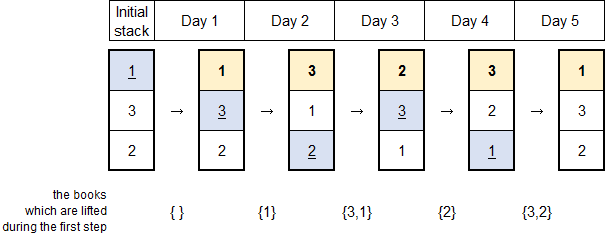题意是n本书排成一堆,按给定的顺序读m次,每次读第bi本书。每本书有重量,读第bi本书的时候,代价就是所有在bi上面的书的总重量。看完后就直接放回书堆的最上层。要求确定一开始书的位置,使得代价尽量小
一开始我就是直接按每本书第一次出现的顺序搞的。比如样例1 3 2 3 1就直接确定为1 3 2 结果数据还真A了……结果最后因为小号交了一遍所以skipped……我真是无话可说……就是因为这个我从1900+掉到1800+了
后来想清楚了
假设我们考虑两本书i,j放的顺序对代价的影响,写一写就很容易发现影响只跟它第一次出现的顺序有关
比如一个看书的序列2 3 ……
有两种放法:2 3 ……或者3 2 ……
显然第一种的代价是w[2],第二种的代价是w[2]+w[3],显然第一种放法优
很容易发现按照2 3的顺序读书读完,它们的位置就唯一确定了。一定是3在2上面。后面也许还会出现要读2和3的情况,但是代价已经确定了
所以就是贪心完模拟啦
#include<cstdio>
#include<iostream>
#include<cstring>
#include<cstdlib>
#include<algorithm>
#include<cmath>
#include<queue>
#include<deque>
#include<set>
#include<map>
#include<ctime>
#define LL long long
#define inf 0x7ffffff
using namespace std;
inline LL read()
{
LL x=0,f=1;char ch=getchar();
while(ch<'0'||ch>'9'){if(ch=='-')f=-1;ch=getchar();}
while(ch>='0'&&ch<='9'){x=x*10+ch-'0';ch=getchar();}
return x*f;
}
int n,m,ans;
int a[200010],b[200010];
int lst[200010],nex[200010],succ[200010];
int main()
{
n=read();m=read();
for (int i=1;i<=n;i++)a[i]=read();
for (int i=1;i<=m;i++)b[i]=read();
for (int i=m;i>=1;i--)
{
nex[i]=lst[b[i]];
lst[b[i]]=i;
}
for (int i=1;i<=m;i++)
{
if (nex[i])succ[nex[i]]=i;
}
for (int i=1;i<=m;i++)
{
int x=succ[i]+1;
bool mrk[1010]={0};
for (int j=x;j<=i-1;j++)
{
if (!mrk[b[j]])ans+=a[b[j]],mrk[b[j]]=1;
}
}
printf("%d\n",ans);
return 0;
}
——by zhber,转载请注明来源




 浙公网安备 33010602011771号
浙公网安备 33010602011771号